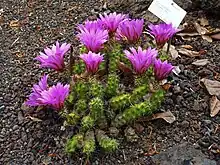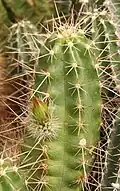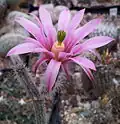| Echinocereus | |
|---|---|
 | |
| Echinocereus triglochidiatus | |
| Scientific classification | |
| Kingdom: | Plantae |
| Clade: | Tracheophytes |
| Clade: | Angiosperms |
| Clade: | Eudicots |
| Order: | Caryophyllales |
| Family: | Cactaceae |
| Subfamily: | Cactoideae |
| Tribe: | Echinocereeae |
| Genus: | Echinocereus Engelm.[1] |
| Type species | |
| Echinocereus viridiflorus | |
| Species | |
|
See text | |
| Synonyms[1] | |
Echinocereus is a genus of ribbed, usually small to medium-sized, cylindrical shaped cacti, comprising about 70 species native to the southern United States and Mexico in very sunny, rocky places. Usually the flowers are large and the fruit edible.
The name comes from the Ancient Greek ἐχῖνος (echinos), meaning "sea urchin", and the Latin cereus meaning "candle". They are sometimes known as hedgehog cacti,[2] a term also used for the Pediocactus and Echinopsis.[3]
Description
The species of the genus Echinocereus grow solitary or branching with prostrate to erect shoots that are spherical to cylindrical. The roots are fibrous or bulbous. The plants reach heights of growth between 1 and 60 centimeters. On the tips of the 4 to 26 ribs, which are mostly clear and only rarely resolved into humps, are the areoles, from which differently shaped spines can arise.
A distinctive characteristic and likely synapomorphy of the genus is the erumpent flowers.[4] The floral buds develop internally and break through the epidermis of the stem. This flower morphology is likely an adaptation to protect the developing buds from low temperatures. Upon maturity, the flowers are usually brightly colored and open during the day. Echinocereus floral color is variable because perianth color reflects pollinator specificity. Red flowers are generally associated with hummingbird pollination, while pink flowers tend to correspond to moth pollination. Their pericarp and floral tubes are studded with thorns, bristles, and sometimes wool. The scar is usually green, but sometimes white in color.
The spherical to ovoid fruits are green to red and mostly thorny. They are mostly juicy and open along a longitudinal slit. The sometimes fragrant fruits contain broadly oval, black, tuberous seeds 0.8 to 2 millimeters long.
Taxonomy
Echinocereus is a genus in the tribe Echinocereeae within the subfamily Cactoideae of the Cactaceae family.[5] The Cactoideae can be further divided into two sister clades, Cactoideae I and II.[6] Echinocereus is situated within the Cactoideae I clade within the Pachycereeae tribe, a tribe that represents a diversification that yielded columnar and arborescent forms. Echinocereus emerged 4.6 ± 1.7 million years ago.[7] Echinocereus is a strongly supported monophyletic genus that is sister to Stenocereus, although there has historically been substantial debate about infrageneric classification because of the genus's high rates of morphological variation and convergent evolution.
Cultivation
Echinocereus spp. are easier to cultivate than many other cacti. They need light soil, a sunny exposure, and a fresh and dry winter to flower. They grow better in soil slightly richer than other cacti. In the wild, several of the species are cold hardy, tolerating temperatures as low as −23 °C, but only in dry conditions.
Species
The following species are recognized in the genus Echinocereus by Plants of the World Online:[8]
| Section | Image | Scientific name | Subspecies | Distribution |
|---|---|---|---|---|
| Costati (Engelm.) N.P.Taylor (1994) |  | Echinocereus berlandieri (Engelm.) Haage | Mexico, Texas | |
 | Echinocereus cinerascens (DC.) Lem. |
|
Texas to Mexico | |
.jpg.webp) | Echinocereus enneacanthus Engelm. | Mexico (Jalisco) | ||
| Echinocereus freudenbergeri G.Frank | Mexico (S. Coahuila) | |||
.jpg.webp) | Echinocereus longisetus (Engelm.) Lem. |
|
Mexico (Coahuila). | |
 | Echinocereus nivosus Glass & R.A.Foster | Mexico (SE. Coahuila, Nuevo León) | ||
 | Echinocereus papillosus Linke ex Rümpler | Texas to NE. Mexico | ||
 | Echinocereus parkeri N.P.Taylor |
|
Mexico. | |
| Echinocereus rayonesensis N.P.Taylor | Mexico (Coahuila, Nuevo León, Tamaulipas). | |||
 | Echinocereus stramineus (Engelm.) F.Seitz | New Mexico to W. Texas and NE. Mexico | ||
 | Echinocereus viereckii Werderm. |
|
Mexico (SW. Tamaulipas, Nuevo León, Coahuila). | |
| Echinocereus | Echinocereus canus D.Felix & H.Bauer | Texas | ||
 | Echinocereus mapimiensis E.F.Anderson, W.C.Hodgs. & P.Quirk | Mexico (Coahuila, Durango) | ||
 | Echinocereus pentalophus (DC.) J.N.Haage |
|
Texas, Mexico (to Jalisco) | |
 | Echinocereus occidentalis (N.P.Taylor) W.Rischer, S.Breckw. & Breckw. |
|
Mexico | |
 | Echinocereus russanthus D.Weniger | Texas to Mexico (Chihuahua, Coahuila) | ||
 | Echinocereus viridiflorus Engelm. |
|
SW. South Dakota to N. Texas and Mexico (Coahuila) | |
| Erecti (K.Schum.) Bravo (1982) | Echinocereus apachensis W.Blum & Rutow | Arizona. | ||
 | Echinocereus barthelowanus Britton & Rose | Mexico (Island Magdalena) | ||
 | Echinocereus bonkerae Thornber & Bonker | Arizona | ||
 | Echinocereus brandegeei (J.M.Coult.) K.Schum. | Mexico (Baja California) | ||
 | Echinocereus dasyacanthus Engelm. |
|
Mexico (Coahuila) | |
 | Echinocereus engelmannii (Parry ex Engelm.) Lem. |
|
United States (Arizona, Colorado, New Mexico, Texas, Utah), Mexico | |
 | Echinocereus fasciculatus (Engelm. ex B.D.Jacks.) L.D.Benson | Colorado to NE. Mexico. | ||
| Echinocereus felixianus H.Bauer | New Mexico, Texas, Mexico (N. Sonora to N. Chihuahua) | |||
.jpg.webp) | Echinocereus fendleri (Engelm.) Sencke ex J.N.Haage |
|
Arizona, California, Nevada, Utah; Mexico (Baja California, NW. Sonora). | |
 | Echinocereus ferreiranus H.E.Gates |
|
Mexico (C. Baja California) | |
 | Echinocereus ledingii Peebles | Arizona. | ||
 | Echinocereus maritimus (M.E.Jones) K.Schum. | Mexico (Baja California). | ||
 | Echinocereus nicholii (L.D.Benson) B.D.Parfitt | Arizona to Mexico (Sonora) | ||
_(6-2-11)_bog_hole%252C_scc%252Caz_-02_(5791622725).jpg.webp) | Echinocereus pectinatus (Scheidw.) Engelm. |
|
Mexico. | |
 | Echinocereus relictus Wellard | Utah | ||
| Pulchellus N.P.Taylor (1985) | Echinocereus acanthosetus (S.Arias & U.Guzmán) Gómez-Quintero & Dan.Sánchez | Mexico | ||
 | Echinocereus adustus Engelm. |
|
Mexico (Chihuahua) | |
 | Echinocereus knippelianus Liebner | Mexico (SE. Coahuila, Nuevo León, Tamaulipas, San Luis Potosí). | ||
 | Echinocereus laui G.Frank | Mexico (E. Sonora, Chihuahua) | ||
 | Echinocereus pamanesii A.B.Lau |
|
Mexico (Zacatecas) | |
 | Echinocereus pulchellus (Mart.) K.Schum. | Mexico (Hidalgo, Puebla) | ||
.jpg.webp) | Echinocereus schereri G.Frank | Mexico (Durango). | ||
| Echinocereus sharpii (N.P.Taylor) Dan.Sánchez & Gómez-Quintero | Mexico (Nuevo León) | |||
.jpg.webp) | Echinocereus weinbergii Weing. |
|
Mexico (Jalisco) | |
| Reichenbachii N.P.Taylor (1985) |  | Echinocereus bristolii W.T.Marshall | Mexico (Sonora) | |
 | Echinocereus chisosensis W.T.Marshall |
|
Texas to Mexico | |
| Echinocereus grandis Britton & Rose | Mexico (Islands de las Animas) | |||
 | Echinocereus palmeri Britton & Rose |
|
Mexico (Chihuahua, Durango) | |
 | Echinocereus primolanatus Fritz Schwarz ex N.P.Taylor | Mexico (to Jalisco). | ||
| Echinocereus pseudopectinatus (N.P.Taylor) N.P.Taylor | Arizona to Mexico (NE. Sonora) | |||
 | Echinocereus reichenbachii (Terscheck ex Walp.) J.N.Haage |
|
Colorado, Kansas, New Mexico, Oklahoma, Texas; Mexico | |
.jpg.webp) | Echinocereus rigidissimus (Engelm.) Rose |
|
New Mexico, Arizona and N. Mexico | |
 | Echinocereus sciurus (K.Brandegee) Dams |
|
Mexico (S. Baja California Sur) | |
 | Echinocereus scopulorum Britton & Rose | Mexico (to Nayarit) | ||
 | Echinocereus spinigemmatus A.B.Lau | Mexico (NW. Jalisco, W. Zacatecas) | ||
 | Echinocereus stolonifer W.T.Marshall |
|
Mexico (SE. Sonora, Sinaloa) | |
 | Echinocereus subinermis Salm-Dyck ex Scheer |
|
Mexico (Sonora, Sinaloa, SW. Chihuahua, Durango) | |
.jpg.webp) | Echinocereus websterianus G.E.Linds. | Mexico (Sonora: Island San Pedro Nolasco) | ||
| Triglochidiata Bravo 1973 |  | Echinocereus acifer (Otto ex Salm-Dyck) Jacobi | Mexico | |
 | Echinocereus arizonicus Rose ex Orcutt |
|
Arizona, New Mexico, Mexico | |
| Echinocereus bakeri W.Blum, Oldach & J.Oldach | Arizona, Nevada, Utah | |||
.jpg.webp) | Echinocereus coccineus Engelm. |
|
New Mexico and Mexico (Sonora, Sinaloa, Chihuahua) | |
| Echinocereus gurneyi (L.D.Benson) W.Blum, Oldach & J.Oldach | Texas. | |||
 | Echinocereus ortegae Rose |
|
Mexico | |
 | Echinocereus pacificus (Engelm.) Britton & Rose |
|
Mexico (Baja California) | |
 | Echinocereus polyacanthus Engelm. | Mexico (Chihuahua to Jalisco). | ||
 | Echinocereus salm-dyckianus Scheer | Mexico (E. Sonora to W. Chihuahua) | ||
| Echinocereus santaritensis W.Blum & Rutow |
|
Arizona to New Mexico and Mexico (Sonora, Chihuahua) | ||
.jpg.webp) | Echinocereus scheeri (Salm-Dyck) Scheer |
|
Mexico (E. Sonora to W. Durango) | |
.jpg.webp) | Echinocereus triglochidiatus Engelm. |
|
Colorado to New Mexico and NW. Mexico. | |
| Echinocereus yavapaiensis M.A.Baker | Arizona | |||
| Wilcoxia (Britton & Rose) N.P.Taylor (1985) | Echinocereus kroenleinii (Mich.Lange) W.Blum & Waldeis | Mexico (Coahuila) | ||
 | Echinocereus leucanthus N.P.Taylor | Mexico (NW. Sonora, NW. Sinaloa) | ||
 | Echinocereus poselgeri Lem. | Texas to NE. Mexico. | ||
 | Echinocereus schmollii (Weing.) N.P.Taylor | Mexico (SE. Querétaro to Hidalgo) | ||
 | Echinocereus waldeisii Haugg | Mexico (San Luis Potosí) | ||
Natural Hybrids
| Image | Scientific name | Subspecies | Distribution |
|---|---|---|---|
| Echinocereus ×kunzei Gürke ( E. coccineus × E. dasyacanthus.) | New Mexico | ||
 | Echinocereus ×neomexicanus Standl. (E. chloranthus × E. coccineus subsp. rosei. ) | Mexico (Chihuahua) | |
 | Echinocereus ×roetteri (Engelm.) Engelm. (E. coccineus × E. dasyacanthus) |
|
New Mexico to SW. Texas and Mexico (Chihuahua) |
Formerly placed here
- Echinopsis candicans (Gillies ex Salm-Dyck) F.A.C.Weber ex D.R.Hunt (as E. candicans (Gillies ex Salm-Dyck) Rümpler)[9]
References
- 1 2 "Genus: Echinocereus Engelm". Germplasm Resources Information Network. United States Department of Agriculture. 2004-02-13. Archived from the original on 2012-10-11. Retrieved 2011-04-10.
- ↑ "Echinocereus". Integrated Taxonomic Information System. Retrieved 2011-04-10.
- ↑ "Echinopsis (Hedgehog Cacti)". Cactus and Succulent Society of Australia. Archived from the original on 2008-07-20. Retrieved 2008-07-29.
- ↑ Sánchez, D., Grego-Valencia, D., Terrazas, T., & Arias, S. (2015). How and why does the areole meristem move in Echinocereus (Cactaceae)?. Annals of Botany, 115(1), 19-26.
- ↑ United States Department of Agriculture. Germplasm Resources Information Network - (GRIN) [Online Database]. National Germplasm Resources Laboratory, Beltsville, Maryland. URL: http://www.ars-grin.gov/cgi-bin/npgs/html/genus.pl?4097 (11 October 2012).
- ↑ Hernández‐Hernández, T., Hernández, H. M., De‐Nova, J. A., Puente, R., Eguiarte, L. E., & Magallón, S. (2011). Phylogenetic relationships and evolution of growth form in Cactaceae (Caryophyllales, Eudicotyledoneae). American journal of botany, 98(1), 44-61.
- ↑ Arakaki, M., Christin, P. A., Nyffeler, R., Lendel, A., Eggli, U., Ogburn, R. M., ... & Edwards, E. J. (2011). Contemporaneous and recent radiations of the world's major succulent plant lineages. Proceedings of the National Academy of Sciences, 108(20), 8379-8384.
- ↑ "Echinocereus Engelm. - Plants of the World Online". Plants of the World Online. 2021-07-08. Retrieved 2022-11-27.
- ↑ "GRIN Species Records of Echinocereus". Germplasm Resources Information Network. United States Department of Agriculture. Archived from the original on 2015-09-24. Retrieved 2011-04-10.
Further reading
- Fischer, Pierre C. 70 Common Cacti of the Southwest. City unknown: Southwest Parks and Monuments Association, 1989.
- Anderson, Miles (1998). The Ultimate Book of Cacti and Succulents. ISBN 1-85967-460-7. Lorenz Books.
- Innes C, Wall B (1995). Cacti' Succulents and Bromaliads. Cassell & The Royal Horticultural Society.
- Anderson, Edward F. : "The Cactus Family" (2001)
- Taylor, Nigel P.: The Genus Echinocereus. Kew Magazine Monograph, Timber Press 1985, ISBN 0-88192-052-5
- Blum, Lange, Rischer & Rutow: Echinocereus, (1998)
External links
 Data related to Echinocereus at Wikispecies
Data related to Echinocereus at Wikispecies Media related to Echinocereus at Wikimedia Commons
Media related to Echinocereus at Wikimedia Commons- Echinocereus on CactiGuide.com
- Echinocereus Online (in German)
- USDA PLANTS Profile
- "Black Lace Cactus (Echinocereus reichenbachii var. albertii)". Endangered and Threatened Species. Texas Parks and Wildlife Department.